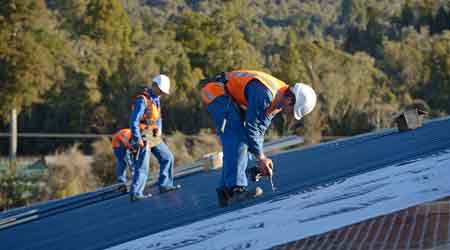Getting Good Roof Design and Installation
Part 2 of a 3-part article describing three critical issues in getting the most out of a roof, including design, maintenance, and repairs
1. Proper Design and Installation
Good roof performance starts with a good design and installation process. Too many roofing projects get off to a bad start when facility managers simply look for the lowest-cost new or replacement roof installation. While lack of maintenance is a major cause of early roof failure, roofs can only be maintained well if the proper type of roof is selected for that application and the contractor installing the roof does so correctly.
The roof design must be appropriate for the application. For example, what level of foot traffic is expected on the roof? Not all roof membranes hold up equally well to repeated foot traffic. Similarly, consider the operations taking place within the facility. Not all membranes hold up well to grease or chemicals that may be exhausted onto the roof’s surface.
Another factor that must be considered when evaluating roof options is the weather conditions where the building is located. How much snow does the region get? What are the seasonal temperature ranges that the roof will be exposed to? Is the building located in a region where high winds occur? In what season will the roof be replaced? Some roofing materials can only be applied when temperatures are within a particular range. All of these issues must be factored into the roof-system selection process.
If the organization lacks the right in-house people with the experience necessary to make the necessary design selection, then it would be wise to bring in an outside, independent consultant. He or she can help in selecting the most cost-effective, appropriate roof system for a given application.
Selecting the most appropriate type of roof is only the first step. A qualified contractor must be selected to perform the installation. If at all possible, managers should pre-qualify contractors before they are invited to bid on a particular project. Being an experienced roofing contractor is not sufficient for pre-qualification. That contractor must be experienced with the type of roof you’re installing.
Some things to look for when pre-qualifying contractors: Do they have experience with that roofing system? For how long? Are they certified by the roofing manufacturer? Will they provide references, with contact information? Are they bonded and insured? What is their track record? How have they resolved conflicts that arose during previous work? Is there any pending litigation concerning their work? Again, if you lack the skills to properly research these and other issues, it may be beneficial to hire a consultant to perform the vetting process.
The process does not stop with the awarding of a contract. Depending on the size and scope of the project, it is often worthwhile to use an outside, independent inspector to monitor the roof installation, and to perform a final inspection of the installation before it is accepted. That inspection will verify that the roof was installed as contracted and is free of defects, and that any installed equipment on the roof has been properly tied in with the roof.
Each of these steps will add to the overall installation cost. For the typical 100,000-square-foot roof installation, managers can expect to spend an additional 5 to 10 percent of the total roof cost for the consultant. While it increases first costs, that investment can be expected to increase the service life for the roof and reduce repair requirements because it will help to identify construction defects to be repaired at the contractor’s expense. As a general rule of thumb, managers can expect that every dollar spent ensuring that the most appropriate roof is installed correctly will return $5 over the life of the roof.
Related Topics:














